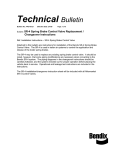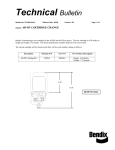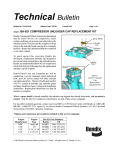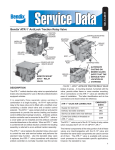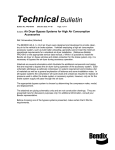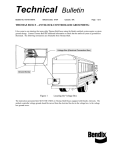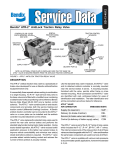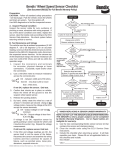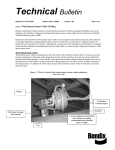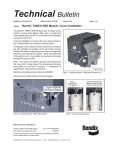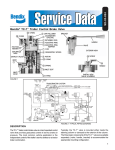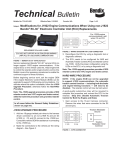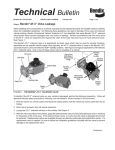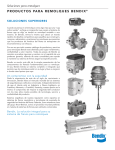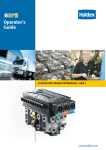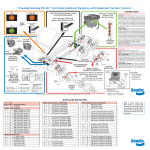Download BENDIX TCH-013-017 User's Manual
Transcript
Technical Bulletin Bulletin No: TCH-013-017 Subject: Effective Date: 7/30/08 Cancels: N/A Page: 1 of 2 Protect Your Bendix® ATR-1™, ATR-2™ and R-14® Relay Valves from De-icing Chemicals Vehicles exposed to harsh winters, de-icing and/or other chemical sprays, often experience excessive corrosion and contamination. As a result, these vehicles typically need maintenance more often, and vehicle parts exposed to de-icing chemicals tend to require replacement sooner. For air system components, one potential result of exposure to corrosion and contamination can be restricted or blocked exhaust ports which can reduce air system performance. R-14® Relay Valve Cover for Balance/ Quick Exhaust Port (Used for AntiCompound Functions) Relay Valve Exhaust Port Regular maintenance routines typically include inspections for corrosion and contamination. Air control valves with smaller secondary exhaust ports, such as the Bendix® ATR-1™ or ATR-2™ traction control valves and R-14® relay valves (See Figure 1), are especially important to check. These valves are often situated in difficult-to-reach locations on the vehicle, however, by following the steps outlined in this Bulletin, the technician can verify that the valves are functioning correctly. Secondary Exhaust Ports (With Cover) are Located Behind the Mounting Bracket Bendix recommends that potentially affected vehicles: FIGURE 1 - EXAMPLES OF R-14® RELAY VALVE AND ATR-1™ AND ATR-2™ TRACTION RELAY VALVES • • Use the specific test(s) below to determine if the valves are functioning properly Install air system components in areas protected from direct splash and road spray, and install splash guards where necessary • Have more frequent inspection and maintenance schedules in regions that have greater exposure to de-icing chemicals Early indications that maintenance is required include reports of “brake drag” — that service brakes appear to be slow to release following a braking or traction control event. When conducting the following Tests, follow all industry standard safety guidelines, including, but not limited to, those shown on page two of this Bulletin. In all cases, consult your vehicle manufacturer’s service manual for details of any further tests that they recommend. To Test ATR-1™ and ATR-2™ Traction Relay Valves: The antilock traction control (ATC) system is tested by connecting the vehicle to a PC with the Bendix® Relay Valve Exhaust Port ACom ™ diagnostics program loaded. (ACom ™ software is available as a free download from www. bendix.com). Run the ATC Valve Test provided in ACom™ diagnostics, and verify that the brakes are fully releasing after the ATC event. If the brakes are slow to release, replace the traction relay valve and repeat the above check. To Test R-14® Relay Valves: Visually inspect (where possible) that the balance exhaust port cover is present on the relay valve; in cases where the cover is missing, replace the entire valve with a new valve. During installation, confirm that the exhaust cover is firmly attached. If the cover is present, verify that the R-14® relay valve used is functioning properly by fully charging the air system and block and hold vehicle by means other than the air brakes. Then make several brake applications and check for prompt application and release of each wheel’s brakes with no perceptible lag. If the brakes are slow to release, replace the relay valve and repeat the above test. If the brakes continue to exhibit slow release, refer to the troubleshooting section in your vehicle manufacturer’s service manual. Bulletin No: TCH-013-017 Subject: Effective Date: 7/30/08 Cancels: N/A Page: 2 of 2 Protect Your Bendix® ATR-1™, ATR-2™ and R-14® Relay Valves from De-icing Chemicals WARNING! Please READ and follow these instructions to avoid personal injury or death: When working on or around a vehicle, the following general precautions should be observed at all times. 1. Park the vehicle on a level surface, apply the parking brakes, and always block the wheels. Always wear safety glasses. 2. Stop the engine and remove ignition key when working under or around the vehicle. When working in the engine compartment, the engine should be shut off and the ignition key should be removed. Where circumstances require that the engine be in operation, EXTREME CAUTION should be used to prevent personal injury resulting from contact with moving, rotating, leaking, heated or electrically charged components. 3. Do not attempt to install, remove, disassemble or assemble a component until you have read and thoroughly understand the recommended procedures. Use only the proper tools and observe all precautions pertaining to use of those tools. 4. If the work is being performed on the vehicle’s air brake system, or any auxiliary pressurized air systems, make certain to drain the air pressure from all reservoirs before beginning ANY work on the vehicle. If the vehicle is equipped with an AD-IS® air dryer system or a dryer reservoir module, be sure to drain the purge reservoir. 5. Following the vehicle manufacturer’s recommended procedures, deactivate the electrical system in a manner that safely removes all electrical power from the vehicle. 6. Never exceed manufacturer’s recommended pressures. 7. Never connect or disconnect a hose or line containing pressure; it may whip. Never remove a component or plug unless you are certain all system pressure has been depleted. 8. Use only genuine Bendix® replacement parts, components and kits. Replacement hardware, tubing, hose, fittings, etc. must be of equivalent size, type and strength as original equipment and be designed specifically for such applications and systems. 9. Components with stripped threads or damaged parts should be replaced rather than repaired. Do not attempt repairs requiring machining or welding unless specifically stated and approved by the vehicle and component manufacturer. 10. Prior to returning the vehicle to service, make certain all components and systems are restored to their proper operating condition. 11. For vehicles with Antilock Traction Control (ATC), the ATC function must be disabled (ATC indicator lamp should be ON) prior to performing any vehicle maintenance where one or more wheels on a drive axle are lifted off the ground and moving. Reference Service Data Sheets: ATR-1™ Antilock Traction Relay Valve . . . . . . . . . . . . SD-13-4811 (BW1794) ™ ATR-2 Antilock Traction Relay Valve . . . . . . . . . . . . SD-13-4812 (BW1791) R-14® Relay Valve . . . . . . . . . . . . . . . . . . . . . . SD-03-1064 (BW1431) ACom™ Diagnostics PC Software . . . . . . . . . . . . . . . . . . . . . . BW2329 (Free downloads available on www.bendix.com) ABS Repair and Diagnostics DVD . . . . . . . . . . . . . . . . . . . . . . BW2538 Visit the Literature Center on www.bendix.com for free downloads of Service Data Sheets or to order copies. For more information, contact your local Bendix representative or the Bendix Technical Assistance Team at 1-800-AIR-BRAKE (1-800-247-2725) Monday through Friday, 8:00 A.M. to 6:00 P.M. EST, and follow the instructions in the recorded message. Or, you may e-mail the Bendix technical assistance team at: [email protected]. ©2008 Bendix Commercial Vehicle Systems LLC 7/08. All Rights Reserved. Printed in U.S.A.


